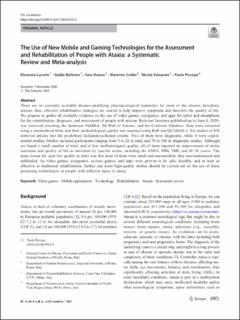| dc.description.abstract | There are no currently available disease-modifying pharmacological treatments for most of the chronic hereditary ataxias; thus, effective rehabilitative strategies are crucial to help improve symptoms and therefore the quality of life. We propose to gather all available evidence on the use of video games, exergames, and apps for tablet and smartphone for the rehabilitation, diagnosis, and assessment of people with ataxias. Relevant literature published up to June 8, 2020, was retrieved searching the databases PubMed, ISI Web of Science, and the Cochrane Database. Data were extracted using a standardized form, and their methodological quality was assessed using RoB and QUADAS-2. Six studies of 434 retrieved articles met the predefined inclusion/exclusion criteria. Two of them were diagnostic, while 4 were experimental studies. Studies included participants ranging from 9 to 28 in trials and 70 to 248 in diagnostic studies. Although we found a small number of trials and of low methodological quality, all of them reported an improvement of motor outcomes and quality of life as measured by specific scales, including the SARA, BBS, DHI, and SF-36 scores. The main reason for such low quality in trials was that most of them were small and uncontrolled, thus non-randomized and unblinded. As video games, exergames, serious games, and apps were proven to be safe, feasible, and at least as effective as traditional rehabilitation, further and more high-quality studies should be carried out on the use of these promising technologies in people with different types of ataxia. | en_US |

